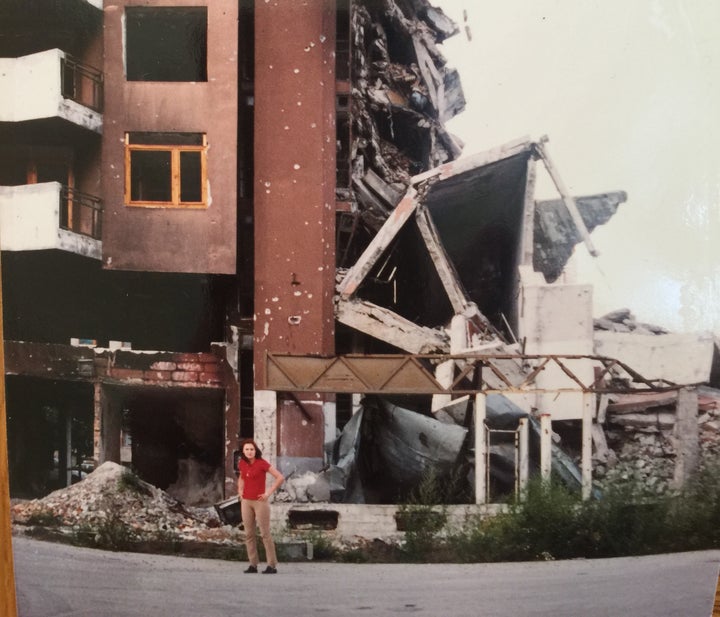
In August of 1995, I watched the US-led NATO Deliberate Forces electrify the skies over my hometown of Bihac, hazardously poised between Bosnian Serb positions on one side and the Serb-controlled precincts of Croatia. Only weeks later, the long convulsive battering of our land at last subsided. NATO’s expedition became one of the most impeccably executed humanitarian military interventions in history.
The Dayton Accord, while imperfect, enshrined a peaceful Bosnian state. Bill and Hillary Clinton walked through our crippled towns, mingling with the Bosnians they saved, offering a passionate benediction to the war torn state. A Bosnian hybrid of American melting pot values seemed destined to take root in the grateful multiethnic nation. The U.S. would ensure the inflow of multilateral aid to rebuild the devastated country in the image of its American saviors. Mission, as they say, accomplished.
Or so it seemed. A radical scion of Islam, Salafism, rolled in, quietly and unchallenged. Salafi mujahideen trickled in unobstructed during the 1990s bloodshed. Their ultraconservative interpretation of Islam began to incubate amongst the historically tolerant Muslims. During the American presence after Dayton, Salafis hid in the shadows and then, upon the U.S. departure, expanded their efforts to fill the moral vacuum by building a welcoming spiritual and ideological home for its converts.
In late April of this year, CIA Director John Brennan made his first visit to Sarajevo, a city proudly ordained as the symbol of a tolerant and Euro-centric version of Islam. He flew directly from Riyad, a birthplace of the ultraconservative Salafism, to huddle with Bosnian officials over the growing threat of terrorism.
On April 23, the day after Brennan’s departure, the official Islamic leadership announced it had attempted to halt the work of the Salafi groups by inviting them to unite with the mainstream congregations in Bosnia. Out of 38 Salafi congregations that accepted to speak to the Islamic leadership, 24 rejected the legitimacy of the Islamic community in Bosnia, declined to become its official members and, with that, denied the legitimacy of Bosnian Islam as Islam at all.
Salafis do not see Muslims as a single phalanx of religious belief and action. To Salafis, theirs is the only one true Islam; all other Muslims are pretenders. The differences between Salafis and other Muslims are clearer to Salafis than the political differences between Donald Trump and Bernie Sanders are to us.
To us, American values seem universal and unimpeachable: democracy, fair play, and hard work. We wonder how anyone cannot hungrily embrace such obvious virtues. But to a poor, forgotten person in a ravaged country, the simple helping hand and moral guidance of a caring mentor can prove far more persuasive.
One Salafi man’s experience typifies the rest: “I turned to faith because of a few close mentors. They introduced me to true Islam. They are caring and far more knowledgeable than me about Islam. I trust them the most and rely on them for information and knowledge. Not on my family, Internet, mosques or anyone else. What they do, guides what I do every day. I have been learning from them for five years. I just received all paperwork and a university scholarship to study in Yemen.”
Salafis, in their initial stage of radicalization, disregard formal education and even religious schools and institutions. They employ the 3Ps ― patience, persistence, and persuasion ― as pillars of their initiation. They resuscitate injured souls one by one: patiently, persistently, and with persuasion. Its members travel by foot, house to house, speaking humbly about sincerity and honesty. These messengers do not cultivate converts from the center of the power spectrum, but from the margins of the powerless. This is how Salafis begin to stake out the foundation to their radicalization pyramid.
Salafis first target people at the bottom of the radicalization pyramid. As the initiate climbs the pyramid, he surveys the panorama of Islam as it was originally passed down by Allah and practiced in the Middle East. Education through personal tutorials, webinars, lays the traction he needs to climb higher.
The mentor’s authority derives from his training amongst the true believers abroad at its source. By the time his student reaches the highest echelon, he is now a soldier fighting for the restoration of the original Islamic kingdom. Commitment to true Islam becomes commitment to saving Islam from destruction by the West. Terrorists become the ones who are willing to “fall off the pyramid” into abyss for the sake of Islam.
Americans instead build schools and train teachers in places likes Iraq, Pakistan and Afghanistan. We build institutions to propagate our values. But these buildings and institutions are hollow compared to the heart-to-heart pedagogy of the Salafi educator.
Salafi teachers do not walk out the door when the bell rings. There is no bell and education is never-ending. The Salafi teacher is a personal ally, confidant and guide. He becomes the sole conduit of all knowledge drawn from Allah’s original well of wisdom. Salafi education is the refined hunger for Islam in its earliest incarnation. To return to the greatness of Islam requires stages of self-purification, and eventually sacrifice to achieve the final restoration of the faith.
One Salafi woman exemplifies how Salafis deliberately cast themselves outside the circle of Western values and education: “To learn about democracy is the greatest evil. Democracy pretends that power belongs to the people, but the only true power in the world rests in Allah.“
Eventually, Salafis fracture population. This is a tipping point in their radicalization effort. It destabilizes regions and devalues billions of dollars we invest to build socially cohesive nations. Our response to them is an engineered military attack, but that alone, without a more adept strategy to re-capture radicalized youths around the globe, only pushes these at-risk populations to societal peripheries where Salafis wait to embrace them.
In its public announcement, the official clergy in Bosnia admitted it had no research, either theoretical or practical, on Salafi teachings and practices. Nor did it therefore have a strategy to re-educate and de-radicalize Bosnian Muslims lost to Salafism. Bosnia is not alone in this. We face a global problem of not understanding how Salafis “educate” people into their beliefs that ultimately drive violent extremism today.
The West, in particular, has much to learn from the Salafis. To win this complex ideological game with Salafism, we need a new perspective on education.
We instruct foreign elites in the hope they will return and propagate our values in their homelands from the top of the social pyramid. But we neglect the peripheral populations, whose “education” Salafis have perfected at the pyramid’s base.
To reverse this highly personalized radicalization, we must join forces with more moderate Islamic communities, like the one in Bosnia, to jointly develop our own de-radicalizing education model. We cannot wage this “hearts and minds” battle with bombs and bombast from on high. Or we will continue to fight an un-winnable war for we have failed to decode the mindset of our common enemy.
